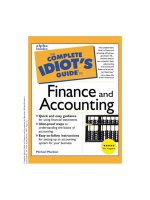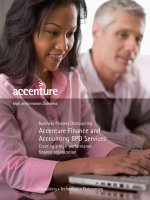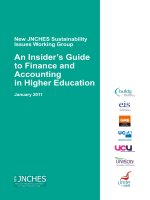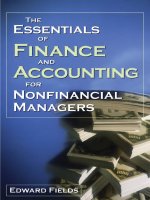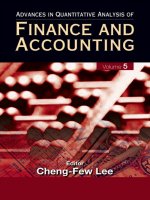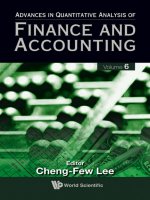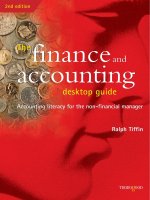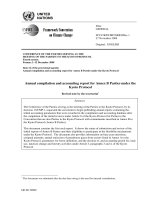The finance and accounting desktop guide Accounting literacy for the non-financial manager pot
Bạn đang xem bản rút gọn của tài liệu. Xem và tải ngay bản đầy đủ của tài liệu tại đây (2.34 MB, 330 trang )
financeand
accounting
desktop guide
Accounting literacy for the non-financial manager
Ralph Tiffin
The
financeand
accounting
desktop guide
Accounting literacy for the non-financial manager
Ralph Tiffin
The
2nd edition
IFC
The finance
and accounting
desktop guide
Accounting literacy for the
non-financial manager
Ralph Tiffin
Thorogood Publishing Ltd
10-12 Rivington Street
London EC2A 3DU
Telephone: 020 7749 4748
Fax: 020 7729 6110
Email:
Web: www.thorogoodpublishing.co.uk
© Ralph Tiffin 2007
All rights reserved. No part of this publication may
be reproduced, stored in a retrieval system or
transmitted in any form or by any means, electronic,
photocopying, recording or otherwise, without the
prior permission of the publisher.
This book is sold subject to the condition that it shall
not, by way of trade or otherwise, be lent, re-sold,
hired out or otherwise circulated without the
publisher’s prior consent in any form of binding or
cover other than in which it is published and without
a similar condition including this condition being
imposed upon the subsequent purchaser.
No responsibility for loss occasioned to any person
acting or refraining from action as a result of any
material in this publication can be accepted by the
author or publisher.
A CIP catalogue record for this book is
available from the British Library.
PB ISBN: 1 85418 309 5
978-185418309-5
RB ISBN: 1 85418 304 4
978-185418304-0
Printed in the UK by Marston Digital
Designed and typeset in the UK by Driftdesign
Special discounts for bulk
quantities of Thorogood books
are available to corporations,
institutions, associations and
other organisations. For more
information contact Thorogood
by telephone on 020 7749 4748, by
fax on 020 7729 6110, or email us:
‘For Robert, Gavin and Hannah’
Blank
Icons 10
Introduction 11
Section 1:
Balance sheets 13
What is a balance sheet? 14
What do balance sheets reveal? 19
Interpreting balance sheet profiles 21
Checklist 23
Section 2:
Balance sheets 25
Balance sheets: structure and contents – UK 26
Interpreting the balance sheet 28
Balance sheets: structure and contents – US 35
Checklist 48
Section 1:
Profit and loss accounts 49
What is a profit and loss account? 50
What do profit and loss accounts
reveal about a business? 55
Checklist 61
Section 2:
Profit and loss accounts 63
Profit and loss accounts in
published or statutory accounts 64
US revenue or income statement
(P & L account) structure and contents 71
Checklist 80
5
CONTENTS
6
Section 1:
Cash flow statements 81
If there are profits there must be cash 82
Cash flow statements 82
What can cash flow statements tell us? 87
Checklist 88
Section 2:
Cash flow statements 89
Published cash flow statements 90
Definitions 94
Compiling and interpreting a cash flow statement 95
Checklist 105
Section 1:
Accounting records and systems 107
Why have accounting records? 108
Distinction between accounting
systems and accounting records 109
Checklist 119
Section 2:
Accounting records and systems 121
Accounting systems and procedures 122
Classic ledger structure 124
Sales system 130
Purchase system 131
Wages system 132
Audit function 135
Checklist 142
Contents
Section 1:
Accounting concepts,
policies and standards 143
Why do we need concepts and rules? 144
Fundamental accounting concepts 145
Fundamental concepts in operation 146
Accounting policies 149
Checklist 152
Section 2:
Accounting concepts,
policies and standards 153
Accounting standards 154
Detailed accounting policies 156
Developing accounting policies 168
A contractor 169
A travel agency 170
Creative accounting 172
Creative accounting illustration 174
Checklist 177
Section 1:
Interpretation 179
Ratio analysis 180
Checklist 189
Section 2:
Interpretation 191
Detailed ratio analysis 192
Profitability ratios 196
Asset turnover analysis 197
Stock market measures 207
Detailed performance measurement – bench marking
211
What is bench marking? 211
Checklist 215
Contents
7
8
Section 1:
Cash budgeting 217
Cash flow forecasts 218
Outline of a simple cash flow forecast 222
Checklist 225
Section 2:
Cash budgeting 227
What is capital expenditure? 228
Cash flow forecasts 232
Non-discounted measures 234
Discounted cash flow techniques and measures 235
Sensitivity analysis 236
Checklist 243
Section 1:
Costing for planning 245
What is costing? 246
Costing for planning 249
Checklist 253
Section 2:
Costing for planning 255
Detailed planning and break-even analysis 256
Checklist 266
Contents
Section 1:
Costing 267
What is costing? 268
Full costing – coping with overheads 271
Problems of overhead allocation 276
Dealing with the problems 278
Checklist 282
Section 2:
Costing 283
How detailed should costing be? 284
Activity based costing 285
Checklist 296
Section 1:
Budgeting 297
Introduction – the operating budget 298
Why budget? 298
Budget stages explained 299
How to budget 300
Checklist 308
Section 2:
Budgeting 309
Setting budget objectives 310
Where do budget objectives come from? 312
Budget objectives and company culture 313
Budgeting systems and techniques 315
Checklist 323
Contents
9
10
Icons
Throughout the Desktop Guide series of books you will see
references and symbols in the margins.These are designed
for ease of use and quick reference directing you to key
features of the text.The symbols used are:
definition
for example checklist
question
and answer
Content and structure
The aim of this text is to explain the meaning and use of
the principal accountancy statements,models and activities
in business life.
The word ‘statements’ includes balance sheets, profit and
loss accounts, cash flow statements and budget reports.
The word ‘models’is used to mean the exercises of costing,
cash flow forecasting, capital expenditure appraising and
other modelling which is essential for sound business
decision making.
The word ‘activities’covers the topics of accounting systems
and controls, record keeping (book keeping) and the
operation of the budget process.
In summary all relevant aspects of business accounting are
covered.
Difficulties in studying accounting
Record keeping, financial reporting and management
accounting models are without exception simple in essence.
There are areas which may become complicated – often this
is due to the amount of detail or the real or perceived need
for detailed analysis or disclosure. For this reason the
chapters are split into two sections. This first section
explains the basic statements, definitions and models, and
the second section explains the topics in more detail and
develops the subject as appropriate.
This approach has been taken to assist the reader to gain a
general understanding of business accounting – by reading
the first sections and studying the second sections as
required. A clear understanding of the principles outlined
in the first sections should greatly assist the reader in not
being overwhelmed by the volume of detail, variations of
essentially simple models and tangential issues which are
met in many accounting texts.
11
Introduction
12
Structure and content detail
The logic of the chapters is to commence with the
fundamental financial statements, showing how they are
compiled and the need for accounting systems and controls.
There is a need for accounting rules and the fundamental
financial statements – balance sheets,profit and loss accounts
and cash flow statements
1 to 3
The need for underlying records
and accounting systems
4
Fundamental accounting concepts, the
need for rules and accounting standards
and detailed accounting policies
5
How to interpret financial statements
6
Cash flow forecasting and appraising
capital expenditure
7
Costing in detail and for planning purposes
8 and 9
Budgeting – the process and how to budget
10
A study of the first sections in the order outlined should
give the reader a clear insight into the main areas of everyday
business accounting.There are many examples of statement
layouts and where appropriate there are review questions
with feedback.The second sections should be consulted
where a deeper knowledge of that particular topic is
required.
Introduction
Balance sheets
What is a balance sheet?
What do balance sheets reveal?
Interpreting balance sheet profiles
Checklist
section one
chapter one
14
A balance sheet is a statement compiled at a specific point
in time, normally at year, period or month ends. It has two
parts or sides which total to exactly equal amounts – it
balances! There are many uses of a balance sheet. It could
be a control statement – the traditional listing of assets to
check that they equal liabilities, or it could be a statement
of historical or updated worth of a business. For these and
also cultural reasons there are many possible formats for a
balance sheet. Contemporary layouts for major trading
countries are given in Section 2 of this chapter.
A simple balance sheet
A simple and useful starting point towards understanding
the key totals and sub totals found in balance sheets is to
consider what the balance sheets two sides contain.
• Net assets employed,tangible,intangible and financial
assets (buildings,equipment,stock,debtors,cash) less
liabilities due to be settled within a short period (a year
or much less).
This is the net worth of the business or capital employed
in the business as visibly seen, recorded, measured and
managed by the directors and employees.
• What finances the business,the capital employed
in the business, but from the perspective of the
investor. It is the owners’ and lenders’ investment in
the business. This side should be exactly equal in
amount to the net assets employed side.
one
•
section one
Balance sheets
What is a
balance sheet?
one
•
section one
Balance sheets
15
Balance sheet
as at (a date)
Net assets X
Tangible, physical, measurable assets
less short-term liabilities
=
Finance X
Share capital plus profits left
in the business by the investors plus loans from lenders
In accounting terms a balance sheet is a statement of assets
and liabilities of a business at a point in time.Assets owe value
to the business and liabilities are value owed to others –
either third parties (suppliers,tax authorities) or suppliers
of finance (shareholders and long-term lenders).
A balance sheet thus shows assets owned and having value
less liabilities to third parties – the net worth or net book
amount in one section.This is then balanced by an equal
amount which represents the amounts owed to the suppliers
of the finance – the shareholders and long-term lenders.
Assets employed
Fixed assets
+ Current assets
- Current liabilities
= Net worth, net book amount or capital employed
Financed by
Shareholders’ Funds or Equity
+ Long-term finance
= Total funding, net worth or capital employed
16
The balance sheet of a simple business follows the basic
definitions below.
Definition of terms
Fixed assets
Normally assets owned by a business and used to produce
products and supply services over a number of years.They
are most often tangible,physical assets – the infrastructure
of a business.They are also assets held for long-term use and
are normally not traded on a regular basis.
In simple terms an asset may be defined as fixed if it will
be used in more than one accounting period (12 months).
Current assets
Normally assets held or owned by a business which are
related to the supply of goods or services – stocks of
products, debtors arising from the sale of stocks or supply
of services.They are normally assets associated with day to
day trading and the aim is to hold them for as short a period
as is possible.
In simple terms an asset may be defined as current if its form
is expected to change within an accounting period (12
months).
Current liabilities
(Or more formally creditors:amounts falling due within one
year.) Normally liabilities associated with day to day trading
– overdraft used to finance debtors or purchase stock;
creditors for stock purchases employee taxes due on
wages/salaries. They are often closely related to current
assets,for example trade creditors will be in respect of stock
held as current asset.Overdraft may exist to finance stocks
or debtors.
one
•
section one
Balance sheets
A liability must be defined as current if it falls due within
12 months of the balance sheet date.
Net current assets (or liabilities)
This figure is simply the net of current assets minus current
liabilities. It is more commonly called working capital.
Long-term liabilities
(Or more formally creditors: amounts falling due after
more than one year).Liabilities associated with financing of
the business – normally to finance the long-term assets –
the fixed assets of a business.
A liability must be defined as long-term if it falls due after
more than 12 months from the balance sheet date.
Shareholders’ funds or equity
A heading covering the investment by shareholders or equity
investors in the business.
The principal amounts are defined as:
Called up share capital
The investment made by the shareholders,normally paid to
the company in exchange for ordinary shares of a fixed value
eg £1 50p or 20p ordinary shares.
Profit and loss account
Profits made in the current and previous periods which have
been left in the business and reinvested, rather than
withdrawn as dividends.This is also called retained profit
or reserves.
one
•
section one
Balance sheets
17
18
Simple Business
Balance sheet as at 31 March 2xx6
Fixed assets Land and Buildings 50,100
Fixtures and Fittings 17,800
Motor Vehicle 6,900
74,800
Current assets Stock 22,500
Debtors 31,600
Cash 2,200
56,300
Current
liabilities Overdraft 13,900
Trade Creditors 23,600
Taxation 8,700
46,200
Net current assets working capital 10,100
Net book amount, capital employed
or net worth 84,900
Financed by:
Long-term loan 15,000
Shareholders’ funds
Share Capital 20,000
Retained Profit
and Loss 49,900
69,900
84,900
one
•
section one
Balance sheets
The first point to remember when interpreting any financial
statements is that the figures are not the creation of an
accountant, but are meant to faithfully represent the
business to which they relate.Careless record keeping (book
keeping) inappropriate and inconsistent rules (accounting
policies) or deliberate miss statement (fraud!) may of
course give unreliable statements,but it is assumed that the
reader is dealing with reliable statements.
The following illustration is an example of what is meant
by the above assertion:
The balance sheets below, with assets and liabilities
expressed as percentages of capital employed are of three
different types of business.
X – a general manufacturer
Y – a telecoms utility
Z – a professional practice which leases its office.
one
•
section one
Balance sheets
19
What do balance
sheets reveal ?
XY Z
Fixed Assets 46% 117% 15%
current assets
Stock/Work in progress 64% 1% 46%
Debtors 68% 25% 62%
Cash 0% 19% 0%
current liabilities
Overdraft -5% -3% -15%
Creditors -73% -59% -8%
100% 100% 100%
Shareholders' Funds 64% 40% 88%
Long Term Loans 36% 60% 12%
100% 100% 100%
20
X has significant percentages of fixed assets – plant and
machinery, significant stock/work in progress and debtors
matched by significant creditors.What you might expect to
find in a general manufacturer’s business.
Y has a very high percentage of fixed assets and significant
debtors. This is what might be expected of a telecoms
company with its heavy investment in infrastructure and its
customers’credit accounts.The high percentage of long-term
loans would also be common in utility companies.
Z has significant percentages of work in progress and
debtors.These are figures which would be the major assets
in a professional firm which does not own its office.
Hopefully the above matching appears reasonable to the
reader. It is obviously easy to do this exercise with knowledge
of the answer! The point with interpretation of figures is that
information should be used firstly to identify key figures.For
example,with the utility,the one asset type which it will have
above all others is fixed assets. Once key figures are
understood and matched, the remainder should fall in
place.
There is a review question and feedback which may be
used to enhance your interpretation skills and develop an
understanding of balance sheet structure. Also in the
second section interpretation of balance sheets is covered
in much more detail.
one
•
section one
Balance sheets
Interpreting balance
sheet profiles
Set out below are the principal activities of six companies
followed by the companies’ balance sheet headings
expressed as percentages of net assets employed.
The activities of the companies are:
A Manufacturer
B Property company
C High street retail stores group
D Multi-national with various activities
E Utility
F House building contractor.
The assets and current liabilities shown as a percentage of
net assets employed are:
123456
%%%%%%
Land and buildings 41 18 21 81 33 168
Other fixed assets 28 36 85 6 22 3
Stock and work
in progress 33 45 8 23 80 –
Debtors 36 56 40 1 4 7
Cash and bank 5 3 5 17 1 –
____ _____ _____ _____ _____ _____
143 158 159 128 140 178
Creditors (34) (47) (21) (28) (29) (9)
Bank overdraft/loans (9) (11) (38) (–) (11) (69)
____ _____ _____ _____ _____ _____
Net assets employed 100 100 100 100 100 100
____ _____ _____ _____ _____ _____
one
•
section one
Balance sheets
21
22
Question:
Which balance sheet profile relates to the appropriate
company activity?
Answer:
Companies 1 and 2 – a similar balanced mix of land and
building, other fixed assets, stocks, debtors and creditors.
These could both be typical traditional manufacturing/
engineering companies or the multi-national which,with its
various activities, would take on an ‘average’ profile.
Company 1 – is taken to be the multi-national and
Company 2 – the manufacturing company (although
similar to 1,company 2 has other higher fixed assets (equip-
ment),stock,debtors and creditors which would fit with the
nature of a traditional manufacturing business).
Company 3 – fixed assets are high in total and there are
other very high fixed assets, eg plant and equipment.
There is also a high level of debtors.These facts alone would
indicate that this might be the utility.Further there is a fairly
high level of loans,again typical of a utility’s balance sheet
with its fixed assets available as security for the high level
of borrowings.
Company 4 – High Street retail stores – a high percentage
of worth is in land and buildings with other lower fixed assets
eg fixtures and fittings.Retail stocks should not be high and
it is unlikely that there will be significant debtors.
Company 5 – house building contractor – the principal
assets will be work in progress – other assets/creditors will
be insignificant.
Company 6 – property company – the principal assets must
be land and buildings – other assets/creditors will be
insignificant.
one
•
section one
Balance sheets
one
•
section one
Balance sheets
23
A balance sheet is at a specific date.
A balance sheet has two sides:
• what the business owns net
• and who owns/funds it.
Balance sheets should reflect the nature of
the business.
Checklist
